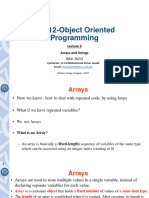0% found this document useful (0 votes)
43 views25 pagesJava12 03
The document discusses Java arrays including one-dimensional and two-dimensional arrays. It covers declaring, instantiating, initializing arrays and accessing array elements. Relational operators and converting string arguments to other types are also discussed.
Uploaded by
metallicgirlCopyright
© © All Rights Reserved
We take content rights seriously. If you suspect this is your content, claim it here.
Available Formats
Download as PDF, TXT or read online on Scribd
0% found this document useful (0 votes)
43 views25 pagesJava12 03
The document discusses Java arrays including one-dimensional and two-dimensional arrays. It covers declaring, instantiating, initializing arrays and accessing array elements. Relational operators and converting string arguments to other types are also discussed.
Uploaded by
metallicgirlCopyright
© © All Rights Reserved
We take content rights seriously. If you suspect this is your content, claim it here.
Available Formats
Download as PDF, TXT or read online on Scribd
/ 25


















































































